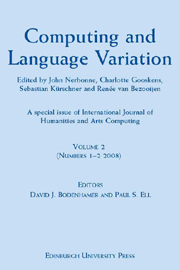Refine search
Actions for selected content:
48274 results in Computer Science
3 - Beyond binary classification
-
- Book:
- Machine Learning
- Published online:
- 05 November 2012
- Print publication:
- 20 September 2012, pp 81-103
-
- Chapter
- Export citation
2 - Binary classification and related tasks
-
- Book:
- Machine Learning
- Published online:
- 05 November 2012
- Print publication:
- 20 September 2012, pp 49-80
-
- Chapter
- Export citation
12 - Machine learning experiments
-
- Book:
- Machine Learning
- Published online:
- 05 November 2012
- Print publication:
- 20 September 2012, pp 343-359
-
- Chapter
- Export citation
Prologue: A machine learning sampler
-
- Book:
- Machine Learning
- Published online:
- 05 November 2012
- Print publication:
- 20 September 2012, pp 1-12
-
- Chapter
- Export citation
Contents
-
- Book:
- Machine Learning
- Published online:
- 05 November 2012
- Print publication:
- 20 September 2012, pp vii-xiv
-
- Chapter
- Export citation
6 - Rule models
-
- Book:
- Machine Learning
- Published online:
- 05 November 2012
- Print publication:
- 20 September 2012, pp 157-193
-
- Chapter
- Export citation
9 - Probabilistic models
-
- Book:
- Machine Learning
- Published online:
- 05 November 2012
- Print publication:
- 20 September 2012, pp 262-297
-
- Chapter
- Export citation
Important points to remember
-
- Book:
- Machine Learning
- Published online:
- 05 November 2012
- Print publication:
- 20 September 2012, pp 363-366
-
- Chapter
- Export citation
Preface
-
- Book:
- Machine Learning
- Published online:
- 05 November 2012
- Print publication:
- 20 September 2012, pp xv-xviii
-
- Chapter
- Export citation
References
-
- Book:
- Machine Learning
- Published online:
- 05 November 2012
- Print publication:
- 20 September 2012, pp 367-382
-
- Chapter
- Export citation
8 - Distance-based models
-
- Book:
- Machine Learning
- Published online:
- 05 November 2012
- Print publication:
- 20 September 2012, pp 231-261
-
- Chapter
- Export citation
4 - Concept learning
-
- Book:
- Machine Learning
- Published online:
- 05 November 2012
- Print publication:
- 20 September 2012, pp 104-128
-
- Chapter
- Export citation
1 - The ingredients of machine learning
-
- Book:
- Machine Learning
- Published online:
- 05 November 2012
- Print publication:
- 20 September 2012, pp 13-48
-
- Chapter
- Export citation
CANONICAL FORMULAS FOR wK4
-
- Journal:
- The Review of Symbolic Logic / Volume 5 / Issue 4 / December 2012
- Published online by Cambridge University Press:
- 19 September 2012, pp. 731-762
- Print publication:
- December 2012
-
- Article
- Export citation
Steps in Scala: An introduction to Object-Functional Programming By Christos K. K. Loverdos, Apostolos Syropoulos, Cambridge University Press, 2010, 504 pp, ISBN 0521747589.
-
- Journal:
- Journal of Functional Programming / Volume 22 / Issue 6 / November 2012
- Published online by Cambridge University Press:
- 19 September 2012, pp. 854-855
-
- Article
-
- You have access
- Export citation
FORMALIZATION, PRIMITIVE CONCEPTS, AND PURITY
-
- Journal:
- The Review of Symbolic Logic / Volume 6 / Issue 1 / March 2013
- Published online by Cambridge University Press:
- 19 September 2012, pp. 87-128
- Print publication:
- March 2013
-
- Article
- Export citation

Computing and Language Variation
- International Journal of Humanities and Arts Computing Volume 2
-
- Published by:
- Edinburgh University Press
- Published online:
- 12 September 2012
- Print publication:
- 04 December 2009
(k+1)-Cores Have k-Factors
-
- Journal:
- Combinatorics, Probability and Computing / Volume 21 / Issue 6 / November 2012
- Published online by Cambridge University Press:
- 11 September 2012, pp. 882-896
-
- Article
- Export citation
10 - Does the Internet have an Achilles' heel?
-
- Book:
- Networked Life
- Published online:
- 05 November 2012
- Print publication:
- 10 September 2012, pp 214-234
-
- Chapter
- Export citation
Index
-
- Book:
- Networked Life
- Published online:
- 05 November 2012
- Print publication:
- 10 September 2012, pp 473-478
-
- Chapter
- Export citation
